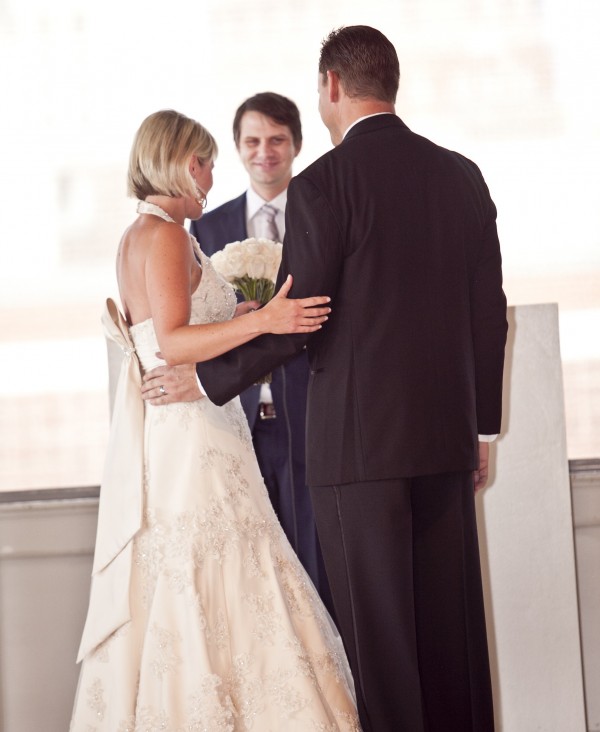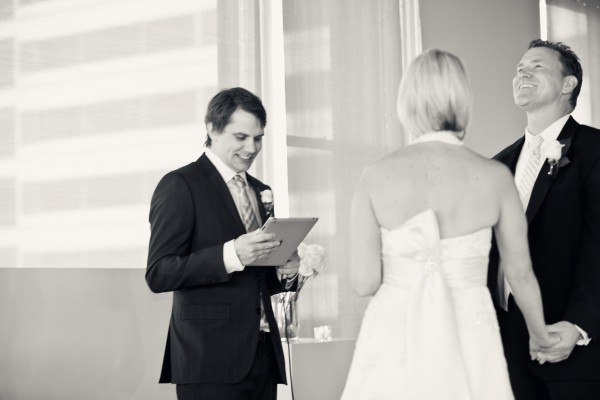Geni Curators: Operation Save the Wedding
The Curators are an integral part of the Geni community. They are essentially the architects of our most prized asset, the World Family Tree. Celebrating them this month gives me an opportunity to tell the story of how the curators enhanced a special event for my family.
 We recently had a wedding in my family, which to any genealogy fan is already incredibly exciting. This one was even more so for me, as my sister, the bride, asked me to officiate the ceremony! Immediately I said yes, of course I would. I didn’t really think about it, and it wasn’t until a little bit later that anxiety struck when I realized what officiating a wedding entailed. I had to get ordained by a church, write a wedding ceremony, and not to mention buy a suit and deliver an important speech. However, I did immediately know what I was going talk about: genealogy and the family tree that we all share. I didn’t tell the families what the speech was about in advance, and refused to share it with even the bride and groom. I wanted it to be a surprise.
We recently had a wedding in my family, which to any genealogy fan is already incredibly exciting. This one was even more so for me, as my sister, the bride, asked me to officiate the ceremony! Immediately I said yes, of course I would. I didn’t really think about it, and it wasn’t until a little bit later that anxiety struck when I realized what officiating a wedding entailed. I had to get ordained by a church, write a wedding ceremony, and not to mention buy a suit and deliver an important speech. However, I did immediately know what I was going talk about: genealogy and the family tree that we all share. I didn’t tell the families what the speech was about in advance, and refused to share it with even the bride and groom. I wanted it to be a surprise.
I’m very proud to work on the graph database that powers the World Family Tree, so I decided to use it to find a common ancestor of my sister, Leslie, and my new brother-in-law, Byron. I have my side of the family pretty strongly connected to the big tree, but nothing for Byron. Luckily Byron’s mother was “one of us” and had quite a few lines traced back pretty far on an Ancestry.com account. I imported her tree and was able to connect Byron pretty quickly. But the big tree was a mess. On Byron’s side, there was a loop in the tree- That is, a persons grandmother was also their daughter! I was working on all of this at about 4am two days before the wedding, panicking, while trying to find sources.
Luckily I had over a hundred of the friendliest and most experienced genealogist in the world available as a resource. I posted a message to the curators at the last minute, who proceeded to go nuts and spawn a multi-page discussion thread ironing out all of the kinks, adding citations and stories to the tree. When all was said and done, Leslie and Byron were 18th cousins thrice removed.
When I informed the wedding goers of the relationship during the ceremony, they all laughed- which took me by surprise. I think people forget that anyone, anywhere, getting married are indeed “cousins”. We take it for granted, because we’re surrounded by it everyday, but those who aren’t are dumbstruck by the notion.
When I sent Erica Howton, one of our curators, a thank you message for all of her hard work, her succinct response summed up the spirit of the curators–
“My pleasure – its my ancestry too!”
Here’s the ceremony as presented at the wedding:
Dearly Beloved, We are gathered here today to celebrate the encounter and resulting love between my sister, Leslie Elaine Bradley, and Byron Atley Bowles Jr. We celebrate, because no ceremony, certificate, or minister can create a marriage. It is an adventure in the most intimate of relationships that is the result of unimaginably improbable circumstances.
Many amazing stories led to Leslie and Byron crossing paths and the love between them. I’d like to share a few of these with you all today.
You see, I’m a bit of an amateur genealogist, and when asked to officiate this ceremony, I immediately knew what I wanted to talk about– and that’s all of the connections– the marriages, the encounters, the immigrations and the struggles that their ancestors went through in order for them to simply exist. Not to mention the amazing improbability of Leslie and Byron meeting, and then rescuing each other from a life without the other.
In one path through the giant family tree that we all share, Leslie and Byron are 18th cousins, thrice removed. Their common ancestor, Byron’s 17th Great Grandfather, and Leslie’s 20th Great Grandfather was John de Beauchamp of Somerset. Now when you step back through your family tree 20 generations you will have nearly a million ancestors. Think about that for a minute. In order for these 2 people to stand before you today with their quirky senses of humor, bright eyes, and zeal for life, millions of people survived their childhoods, struggled through puberty, found love, cared for their children, and mourned their loved ones when they passed on.
There are some very notable stories in the histories of these two. On Byron’s side, the Bowles of Penhow were one of the most powerful families in Wales during the Wars of the Roses, they married into the famous Seymour family that eventually gave them Jane Seymour, Henry VIII’s third wife. The family seat was Penhow Castle in southern Wales, it’s actually the oldest inhabited castle in Wales to this day. During the Wars of the Roses, Thomas Bowles left Penhow and led a siege upon a town called Berwick-upon-Tweed on the Scottish border. He won, and was knighted by the Duke of Gloucester.
In 1586 John Bowles was born in London, and he met a woman named Martha Polley and fell in love. They immigrated to the American colonies sometime between 1612 and 1621, having two kids, Charles and John Jr, before before John Sr died in 1664, present day Kentucky. The Bowles family then spread throughout the United States and Canada.
On Leslie’s side, our 6th Great Grandfather was Captain Francis Bradley. Captain Francis was a Revolutionary war hero, he led a Militia that became known as the Charlotte Hornets. They got their name from the British General Cornwallis, who remarked about the resistance met in North Carolina “There’s a rebel behind every bush, it’s a veritable nest of hornets.” Physically Captain Francis was said to be the strongest man in the county. After the British had lost Charlotte, Captain Francis happened upon four Tories sneaking through his property on retreat. He attempted to take them prisoner, but a violent scuffle ensued and they shot him with his own gun. A quote from the newspaper of the time: “Bradley was a very stout man, and with out weapons would have been a match for all four of them; a man of cool and deliberate courage, much respected by all who knew him, and his death much regretted.” The four men were hanged, and a statue of Francis marks where the attack took place, in Dallas, North Carolina.
Robert Abernathy was born in Scotland in 1624, in the Town of well, Abernathy. He was on the losing Scottish side against Oliver Cromwell’s English Roundheads in the battle of Dunbar on September 3rd 1650. Along with over 10,000 other men, he became a prisoner of war and was shipped to America, arriving in Jamestown, Virginia in 1652. He served four years as an indentured servant then was freed. His descendants eventually settled in Catawba County, North Carolina, where James Abernathy met Alice Baldwin. They had one child, a girl named Lucy Bell. Lucy was supposedly a beautiful socialite, and gave three children to her husband, John Looper, before dying during an operation to remove liver cancer at 26. She would never know her children, Wilma, Judson, and Leslie and I’s grandfather James Vincent Looper.
Deacon Edward Converse came to the colony of Massachusetts on the ship “Lion” in 1630 with his wife and three children. His name is fourth on the list of the thirteen original inhabitants of the new town of Charleston. He established the first ferry to Boston, which he eventually donated for the support of Harvard College, whose founder, John Harvard, was his personal friend. Edward later joined others in founding the town of Woburn, Massachusetts. He was one of the most prominent citizens of Woburn as long as he lived. His house was situated on main street, and was thirty by thirty-five with nineteen windows– at a time when windows were luxuries. On the opposite side of the street was the Converse mill, which was conducted by several generations of his descendants. His grandson, again named Edward, built the well known Converse Tavern. I quote: “He was a man of energy, and sound judgment, much employed in public affairs, was one of the constituent members of the church, and served as committee in building the meeting house. He was chosen to repair bridges, help survey doubtful bounds, collect, receive and distribute school money, and ‘settle with distrained Baptists on as easy terms as he could.’ He was active in military affairs, serving as ensign for many years. Deacon Edward Converse is Byron’s 10th Great Grandfather through his mother’s side.
Now, It’s very touching to step through these relationships and events that unite our two families, but it also shines light on the improbability of them finding each other. What if John and Martha Bowles missed the boat? What if Robert Abernathy and the Scots had won the battle of Dunbar and never became a slave? What if Lucy had succumbed to her liver cancer 2 years earlier?
It’s mind-blowing to think about the series of events that took place, that when pieced together result in the powerful and rare form of love that we’ve all witnessed in Leslie and Byron. I reflect in wonderment at the Billions and Billions of events that led up to this moment.
With that in mind, May I have the rings please? (best man hands them to me)
Historically, the wedding ring was connected to the exchange of valuables at the moment of the wedding, not a symbol of eternal love and devotion. It is a relic of the times when marriage was a contract between families, not individual lovers. However, they do have a modern purpose– which is to claim a person as yours. Just as European explorers used flags to claim lands around the world for their home country, Leslie will claim Byron, and Byron will claim Leslie.
(Exchanging of Vows)
By the power invested in my by the church of, well of the internet, I pronounce you man and wife.
Byron, you may kiss the bride.








 Genealogy Discussions
Genealogy Discussions Genealogy Projects
Genealogy Projects Popular Genealogy Profiles
Popular Genealogy Profiles Surnames
Surnames The Geni Blog
The Geni Blog The World Family Tree
The World Family Tree